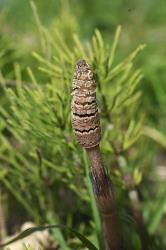Terrestrial ferns. Underground stems long-creeping, freely branching, bearing wiry roots. Aerial stems green, erect, branching in whorls or unbranched, usually with a central hollow surrounded by two rings of smaller alternating cavities, jointed, longitudinally grooved, siliceous, glabrous, bearing leaves in sheathing whorls at the nodes. Leaves united laterally into a sheath, toothed at the apices, equalling the number of stem grooves. Veins undivided in each leaf. Strobili terminal on main aerial stems, or sometimes on lateral stems, or on specialised shoots lacking chlorophyll, bearing stalked peltate sporangiophores arranged in whorls. Several sporangia pendent from adaxial surface of heads of sporangiophores; each sporangium sessile, lacking an annulus and dehiscing by a longitudinal slit, containing 1000s of spores and elaters. Homosporous; spores alete, spherical, attached to four coiled elaters, granulate to smooth, chlorophyllous.
A genus of 15 species. Equisetum comprises two well-marked subgenera, Equisetum and Hippochaete (Hauke 1990). Subgenus Equisetum is distinguished by its superficial stomata, which are usually scattered or in bands of two or more stomata wide, by its non-apiculate strobili, and its annual, regularly branched, aerial stems. Subgenus Hippochaete has sunken stomata in single lines, apiculate strobili, and usually perennial, often unbranched, aerial stems. Of the species occurring in New Zealand, E. hyemale belongs to subgenus Hippochaete, and E. arvense and E. fluviatile to subgenus Equisetum.
| 1 | Fertile and sterile stems dimorphic; sterile stems with abundant whorls of branches | arvense |
| Fertile and sterile stems monomorphic; sterile stems unbranched, or only sparsely branched | 2 | |
| 2 | Sterile stems 400–600 mm tall, sparsely branched; ridges on aerial stems smooth; apices of strobili obtuse | fluviatile |
| Sterile stems 1000–2000 mm tall, usually unbranched; ridges on aerial stems with two rows of tubercles; apices of strobili apiculate | hyemale |
Virtually cosmopolitan except for Australia and New Zealand. Two species fully naturalised, and one casual, in New Zealand.
| Category | Number |
|---|---|
| Exotic: Fully Naturalised | 2 |
| Exotic: Casual | 1 |
| Total | 3 |
n = 108 (Hauke 1990).
Equisetum was possibly first introduced to New Zealand in 1900 by Leonard Cockayne who obtained four species from Karl Goebel in Munich and grew them in his garden at New Brighton. He quickly regretted his choice of plants and shortly after had to eradicate them before they became firmly established (Thomson 1979, pp. 390–391).




